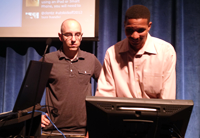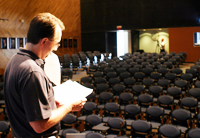
Cover Story
The Annual Kickoff Was a Triumph of Technology

Jason Brewer and Larry Frazer prepping for the Kickoff.
When Brett Coryell (UTS) sat down with our Kickoff planning committee, he was brimming with ideas regarding how best to deliver his message this year. A key component for Brett was to foster "back-channel communication," where the real-time thoughts and ideas within the division could be captured and discussed. He envisioned a more interactive experience that would encourage even our most introverted thinkers to participate.
Like P.T. Barnum himself, Brett wanted to dazzle his audience, not with dancing elephants and death-defying trapeze, but with a visually-responsive presentation that utilized enormous wireless connectivity, modern communication tools, and a suite of information-blending software. Please pass the popcorn! Much of the planning began with the phrase, "Wouldn't it be great if..."
In planning the event, the team took on five distinct new challenges:
- employing a large-scale licence of Adobe Connect to allow as many as 200 concurrent internet accesses to the event
- transforming Tull Auditorium from a wireless black hole into a thriving wireless hotspot
- creating human interaction with technology via Kinect for Windows
- utilizing our own videographical competency to capture the audience, the man, and the message simultaneously
- implementing a confidence monitor to allow a speaker to maintain line-of-sight with the audience and the presentation behind him
It was a bold plan and while there were a few hiccups along the way, the overall deployment was a success thanks to the expertise of members of Academic Technology Services, Enterprise Services, Infrastructure, and Integration. I want to pass along my sincerest appreciation for the collaborative work of everyone involved with Brett's Annual Kickoff.
Larry Frazer (Enterprise Services) architected the Adobe Connect solution to deploy various pods for the PowerPoint presentation, a Twitter feed, real-time poll questions, and constant remote access. He stretched the limits of the implementation and learned many new lessons for future deployments.
The effort to dramatically improve the wireless density in Tull Auditorium was a resounding success. It was comforting for me to know that this part of the Kickoff was in such professional hands. The trio of Tommy Barwick (Enterprise Services), Stan Brooks (Infrastructure), and Tillie Loza (Enterprise Services) kept me so consistently apprised of the progress of this portion of the Kickoff that it became the least of my worries.
Alvin Wilder (Enterprise Services) handled the installation of new data ports in Tull and the team of Stan Brooks, Norman Butler, Chad Street, and David Topper (all of Infrastructure) designed and implemented a temporary wireless configuration that managed the data traffic perfectly during the event. We had over 60 people connecting to the Adobe Connect session as well as many more Smart devices in the room that were tweeting and texting into the back channel communication stream that we were trying to capture.
 I have not seen any of the data that Stan's team captured regarding throughput but I can relate two specific testimonials to the project's success:
I have not seen any of the data that Stan's team captured regarding throughput but I can relate two specific testimonials to the project's success:
During our Tuesday run-through when we did NOT have the temporary wireless setup, the eight of us who were in the room had all kinds of connectivity issues.
During the event, Chris Weberg (Enterprise Services) needed to step out of the auditorium to take care of some work and immediately lost all connectivity as soon as he passed the threshold of the room. Inside, he was fully operational on multiple devices. Two paces through the door, he was dead in the water.
The speed with which we implemented this solution and the success of the implementation are a testament to the competency our teams have developed in the arena of wireless implementation.
Lee Clontz (Academic Technology Services) impressed us all with the gamification-inspired Kinect for Windows, that allowed Brett to control his presentation with mere hand movements, predefined and configured, without the use of a keyboard or clicker. Although we learned that the bright lights of a stage sometimes wreck havoc with a technology that captures hand-movements, the effectiveness of the device should encourage future implementation of the technology.
I am continuing to complete the post-production of our video capture of the event via three separate sources: a static HD camera for the long shots of the room, a second camera to zoom in on Brett himself, and a data recording of everything we witnessed in Adobe Connect. Steve Bransford (Academic Technology Services) architected the solution and Shannon O'Daniel (Academic Technology Services) provided a steady hand on one of the cameras. When this three-sourced capture is completed, it will give the rebroadcast the feel of a television show.
Ryan Roberts (Academic Technology Services) planned the use of a large confidence monitor, carefully situated out of sight near the front of the stage, that allowed Brett to visually monitor the timing of his presentation without looking over his shoulder to see his slides. Instead, Brett could maintain eye contact with the audience and "have confidence" that what was on the screen behind him matched what was on the screen in front of him. Jason Brewer and Steve Witte (Academic Technology Services) provided key assistance in implementing this solution.
Lastly, I want to thank my support team of Mark Kawasaki (Integration), who was our Technology Emcee, Sebreanna Echols (IT F&A), who handled logistics, Brenda Rockswold (Academic Technology Services), for her event expertise, and my Marcomm partner in crime, Norman Hulme (Integration), for his graphic design, strong ideas, and ability to help us recognize when something isn't going to work! And of course, Brett Coryell himself...the star of the show!
The overall effort embodied the very themes of Brett's presentation: artful innovation and forward thinking. Job well done, people!
- Wade Moricle, Marketing and Communication Specialist, Integration